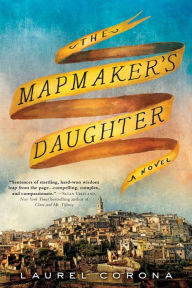This novel is set in 15th century Spain and Portugal, and the main character is Amalia Cresques. The book is structured as a series of flashbacks from the point where Amalia is an elderly woman sitting in an empty room waiting to get on a ship and leave Spain forever. Through the course of the story, the spirits of the dead visit her and prompt memories of important phases of her life.
Her recollections begin with her childhood in Seville. Her family are conversos, Jews who have converted to Christianity. Her mother still practices the ancient religion in secret. Her talented father is a map-maker who works for the Count of Medina-Sidonia, a nobleman closely associated with King Henry the Navigator. Explorations along the coast of Africa are shifting into high gear. Amalia's father creates maps based on the information brought back by ship's captains. Amalia accompanies her father when he accepts a new job in Portugal. After his death she chooses to live openly as a Jew. Some places are safer than others, but there's always the risk of persecution, attacks, and exile. The story tracks Amalia through her marriage to a ship's commander, the birth of her daughter Eliana, and her years as a tutor to royal princesses.
There is a fascinating mix of early Renaissance history that relates the conditions before and after Aragon and Castile were united by the marriage of Ferdinand and Isabella, along with the bitter rivalries in the Portuguese royal family. Jews are not the only victims. The Spanish and Portuguese begin to use the enslavement of Africans as a means to finance maritime expeditions; a heinous greed-driven practice justified by putrid religious rationalizations. Toward the end of the book, Isabella and Ferdinand launch the Spanish Inquisition. Torquemada makes it increasingly difficult for conversos or Jews to survive in the country. As the book ends, the Jews are exiled from Spain. The history of Jews in Europe has many shameful and violent episodes of persecution, and this is but one of them.
Amalia relies on her Jewish faith and magical traditions to remain strong and keep her dignity in spite of adversity. The book includes rituals, prayers, blessings, and methods for preventing the Evil Eye. The men study the Zohar, one of the original sources for the Kabbalistic material infused into Western magic during the early Renaissance. The book's characters demonstrate immense faith in times of danger; it cements their courage and determination to survive. Their familial love and traditions provide stability amidst upheavals.
“The Mapmaker's Daughter” is a time-capsule that tracks the rapidly changing political, religious, and economic conditions that occurred as other continents were discovered. Amalia's story gives an insider's view of contemporary lifestyles, the lives of women (little of which is well-documented), the clash of religions, and the vicious and sometimes lunatic actions of the monarchs who ruled during that period.
This book is recommended for its interesting plot line and the skillful blending of historical facts and religious practices in a fictional setting. People who enjoy well-written historical novels will enjoy this book.
~review by Elizabeth Hazel
Author: Laura Corona
Sourcebooks Landmark, 2014
360 pg, $14.99
The Map-Maker's Daughter

©
2010 - 2025
Facing North
